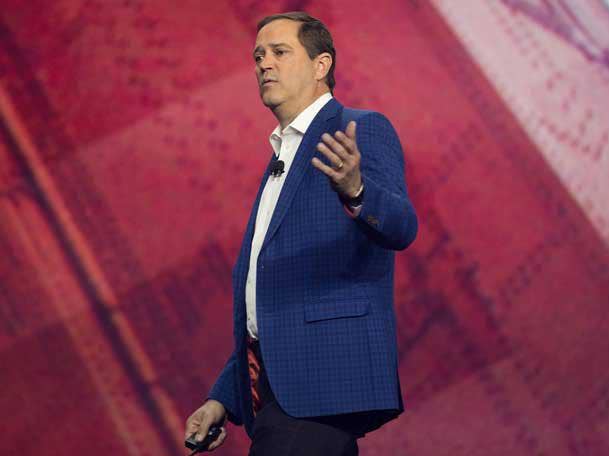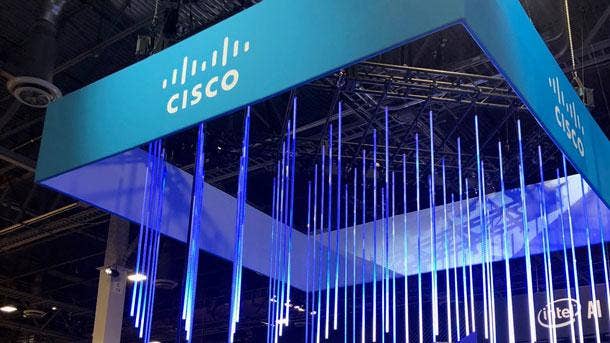Chuck Robbins: ‘Flexibility And Choice’ Will Distinguish Cisco’s XaaS Strategy
‘I think we’re starting with a strong foundation with our partners and really having a high degree of trust, commitment to innovation, and obviously, a commitment to giving customers the choice of how they want to consume things,’ Cisco CEO Chuck Robbins tells CRN. ‘I feel good about the transition.’

Cisco as a Service
Cisco hasn’t played coy about its need for transformation. The well-established networking leader that got its start in the hardware arena has made great strides in recent years to shift its focus to software, services and subscriptions, and now, is working on moving to an everything as a service, or XaaS selling motion.
Cisco Chairman and CEO Chuck Robbins in August during the company’s fourth-quarter fiscal 2020 earnings call said that Cisco would be transitioning the majority of its portfolio to an everything-as-a-service model. Robbins made it clear that every Cisco product would be evaluated, and nothing was off the table.
Robbins, Cisco’s CEO for the past five years, sat down with CRN at the Cisco Partner Summit 2020 Digital event to talk about the vendor’s focus on moving to the new selling motion, especially as the COVID-19 pandemic continues to impact IT spending around the globe. Robbins shared the resources Cisco has in place to help partners make the transition, how partners are reacting, and the partner advantage to working with Cisco in this space.
Here are excerpts from the conversation.

What resources is Cisco putting in place to support the XaaS buying model for partners and customers?
As we’ve been [going] through this transition to more software and subscription, and [software as a service] SaaS, obviously, the operational infrastructure of the partner programs is super important. So, the teams have been working on our ability to operationalize this transition before the pandemic. I think that most of that work will be done in the next couple months.
I actually had a discussion earlier this week about the partner profitability portion of this. It’s something that we’re working through right now. The teams are working on getting all of it nailed down and I think it’ll be it’ll be probably one of those examples where I said at the end of my [Partner Summit 2020 Digital] keynote that we’ll make some mistakes, and we’ll learn, and we’ll fix them. Hopefully we get it right. But I think this is an area that we’ll [have] to see how the market adopts these solutions and then we’ll probably have to adapt the programs appropriately.

How does Cisco’s XaaS model compare to competing vendor models, and where is the partner advantage to partnering with Cisco in this space?
I think the breadth of our portfolio and the flexibility with choice is really what I think will differentiate us. When you look at our ability to talk to a customer about delivering technologies, either on-prem[ise] or from the cloud, delivering our technology, to help them manage either a public cloud environment or a private cloud environment, the decisions we’ve made around some customers who want to see us disaggregate the hardware and software components – we’ve shown a great deal of flexibility. I think that’s one of the biggest things that that will differentiate us going forward.
I think we’re starting with a strong foundation with our partners and really having a high degree of trust, commitment to innovation, and obviously, a commitment to giving customers the choice of how they want to consume things. So, I feel good about the transition.
Just to be clear, this is not going to be a nine-month transition. This is going to be a very slow transition. Some customers will never move this, and some will. What we’re really talking about is choice. But, a lot of customers won’t do it this way. We just need to have the optionality in our portfolio.

How are partners reacting to the XaaS selling motion?
[Some of] our technologies that are naturally sold as a service; we’ve had partner profitability programs in place for the last few years. So, whether it’s a SaaS application or it’s a hybrid app, or hybrid, cloud-managed piece of equipment, or it’s a subscription-based piece of software running on-premise, we’ve got all that stuff in flight.
I think the question is, when you start selling compute based on capacity -- so the customer would commit to a certain amount that they would burst to a certain amount and that affects how they’d pay for it -- those are the [deals] that are a little bit more complex. But I know that the teams are working through that right now.
The partners have been working in this space for a very long time. They’ve actually for years have been taking our technology and bundling their managed service capabilities around it and delivering solutions as a service to the customer. So, I think many of them already have the capabilities. I would say that all of us, both Cisco and our partner community; one of the big muscles that we’re building is really around the adoption aspect of selling things as a service. I think that’s probably the biggest thing that we really need to continue to build on is our capabilities. And then obviously, the partners need to be able to build their capabilities and practices around that.

Are you getting any pushback from partners on this selling motion?
With every transition that occurs, there are partners that don’t make the transition. That’s been the case forever. But, I think this is such a prominent industry trend -- this isn’t something that we’ve made up – people want to consume this stuff as a service, and when we see those things that are so customer-driven, partners tend to make the transition a lot faster. When we’re trying to push a transition with the partner community, in many cases, they might want to us to go slower, but when their customers are the pulling force, partners tend to move as quickly as they need to.

What are Cisco’s next steps in its XaaS transformation and what should partners prepare for?
One of the things that I believe is there’s this notion of taking our core networking products, and then bundling financial [incentives] around them and then selling them as a service. But then there’s a truer form, which is extracting the technology out of some of the products, and then delivering it virtually via software as a service. So, there’s two different elements and then there’s the consumption-based model.
I think that as we continue to evolve all three of those, the partners just need to do what they do well, which is still find a way to come in and add value. I think the trick always is, where does the value proposition for the partner evolve to based on whatever the transition is that’s going on, whether that’s historically been a technology transition, or, in this case, a business model transition? Or, in the case of us opening up APIs on our core platform, seeing the partners build development practices on top of infrastructure. I think that there’s some that are very innovative and there’ll be leaders, and I think that that will determine how the how the partner value proposition evolves as this transition occurs.